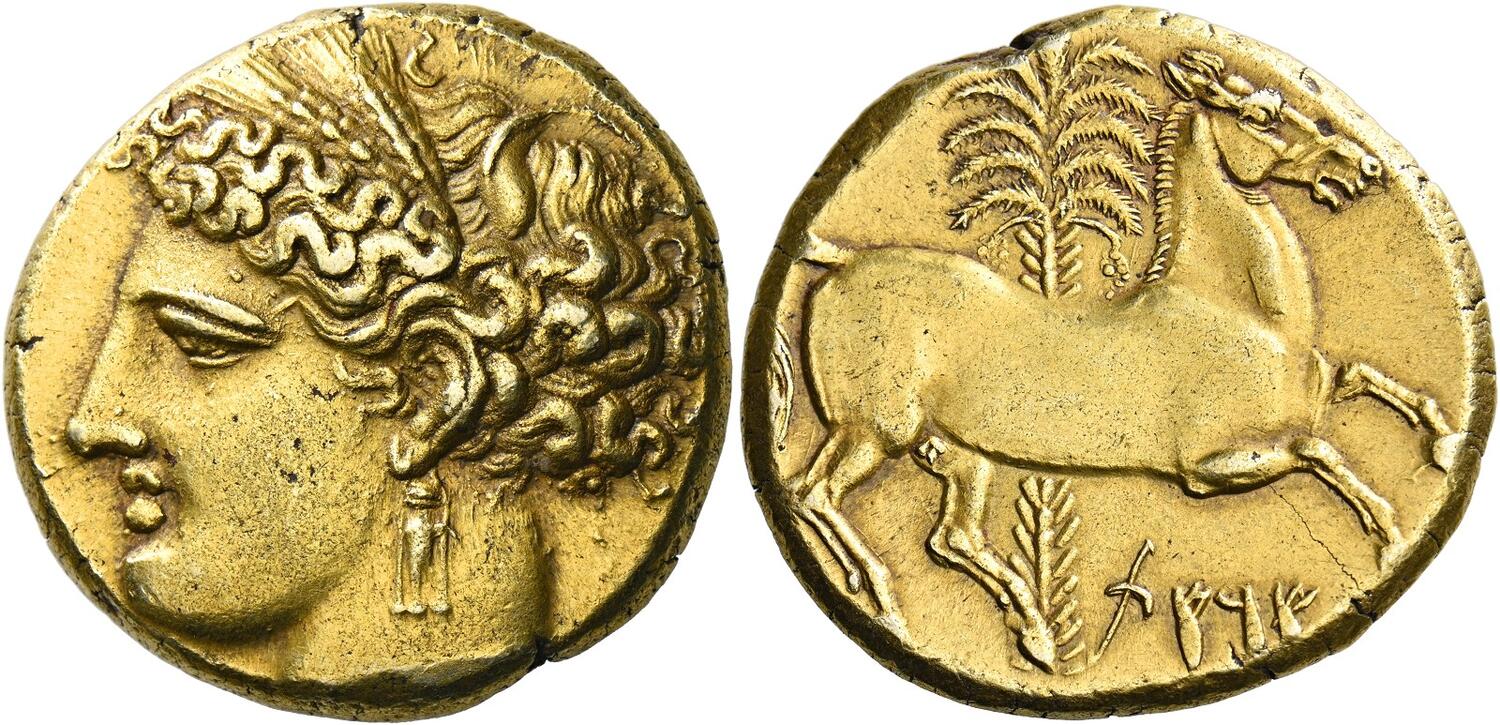H 327 - Carthage, electrum, 22.60g (265-255 BCE)
From SILVER
265 BCE - 255 BCE Electrum 9,447 kg
Description
| ObverseInscription or printing placed on the obverse.: | Head of Tanit (Kore-Persephone) l., wearing reed and barley-wreath, triple pendant earring and necklace (only partially visible) |
| ReverseInscription or printing placed on the reverse.: | (Punique).Horse prancing r., below, b'rst in Punic characters and behind, palm tree with two clusters of dates |
Mint and issuing power
| MintIdentifies the place of manufacture or issue of a numismatic object.: | Carthage | Ancient regionAncient region.: | Zeugitana | Modern countryModern country: Tunisia | AuthorityIdentifies the issuing power. The authority can be "pretended" when the name or the portrait of X is on the coin but he/she was not the issuing power. It can also be "uncertain" when there is no mention of X on the coin but he/she was the issuing power according to the historical sources: | Carthaginian Empire |
Chronology
| FromIdentifies the initial date in a range assigned in a numismatic context. | 265 BCE | toIdentifies the final date in a range assigned in a numismatic context.. | 255 BCE | PeriodTime period of the numismatic object.: Hellenistic 323-30 BC |
Physical description
| MetalThe physical material (usually metal) from which an object is made.: | Electrum http://nomisma.org/id/el | Median weightMedian of the weights of numismatic objects (in grams). in grams | 22.60 | DenominationTerm indicating the value of a numismatic object. Examples: tetradrachm, chalkous, denarius.: | decadrachm |
StandardStandard.: |
Image

H327 Carthage Tanit and horse.jpeg [1]
References
| Die study referencePublication of the study: | Jenkins - Lewis 19631Jenkins - Lewis 1963, (série VIII). | ||
| Coin series referenceReference to coin series study: | RQEMH2RQEMH, n° 327 | ||
Obverse dies distribution
| FrequencyFrequency of specimen in distribution. ᵖ | Number of obversesNumber of obverse dies. ᵖ (o) | % (o) | Number of coinsNumber of coins. (n) | % (n) | Die nameName(s) of the die(s). |
| 4 | 1 | 50 | 4 | 26.67 | 374 |
| 11 | 1 | 50 | 11 | 73.33 | 368 |
| Total | 2 of 2 | 100 | 15 of 15 | 100 |
Reverse dies distribution
no distribution is available
Quantification
| Number of obversesNumber of obverse dies. ᵖ (o) | 2 | Number of singletons (o1)The number of singleton coins. ᵖ | |
| Number of reverse diesNumber of reverse dies. (r) | 7 | Number of coinsNumber of coins. (n) | 15 |
| Coins per obverse dieNumber of coins per obverse die. (n/o) | 7.5 | Coins per reverse dieNumber of coins per reverse die. (n/r) | 2.14 |
| Reverse per obverse ratioRatio of obverse dies divided by reverse dies. (r/o) | 3.5 | Percentage of singletons (o1)number of coins (n) divided by the number of singletons (o1) ᵖ | % |
| Original number of dies (O) (Carter 1983 formula)The estimation of the number of coins according to Carter 1983 ᵖ | 2.09 | Coins struck if 20,000 as average productivity per dieCoins made if the average productivity for obverses (according to Carter) is 20,000. ᵖ | 41,800 |
| Original number of dies (O) (Esty 2011 formula)The estimation of the number of coins according to the singleton formula in Esty 2011 ᵖ (O) | 2.31 | Survival rate if 20,000 as average productivity per dieSurvival rate if average productivity is 20,000. ᵖ | 0.00036 |
| Coverage (o = % of O) (Esty 1984 formula)Esty 1984 - coverage (% of O) ᵖ (o = % of O) | % | Die productivity if survival rate 1/2,000Average productivity if survival rate is 1/2,000. ᵖ | 14,354.07 |
| Weight of silver (in kg) if 20,000 coins per die (O = Carter formula)Carter 1983 * Median weight * 20000 (*10 if gold or electrum) ᵖ | 9,447 kg <br /> 9,447 kg | Die productivity if survival rate 1/5,000Average productivity if survival rate is 1/5,000. ᵖ | 35,885.17 |
Remarks